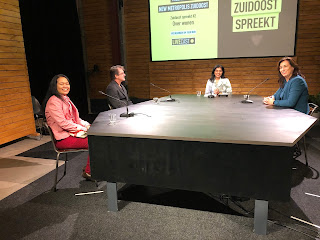KLEIBURG: MODERN ARCHITECTURE OF AMSTERDAM
Amsterdam is famous for its canals and old buildings but the city has also a relatively rich collection of modern architecture. One of them is Kleiburg, in Amsterdam Southeast, a building with more than 500 apartments.
Kleiburg is part of Bijlmermuseum, an open-air
and living museum consisting of a built environment (6 appartment buildings, 1100
meter metro viaduct, and green space)
that has been built between 1967 and 1972 in the area called Bijlmermeer,
Amsterdam Southeast. Since 2019 all elements and areas of the Bijlmermuseum
gain status as the protected cityscape
of Amsterdam.
The apartment building of Kleiburg was built
in 1969 and ready in 1971. The whole
building was closed from January 2009 until 2012 for a new plan. Finally, it
was destinated as a self-renovated project between 2013-2016 where buyers
purchased a basic empty living space ready for renovations.
All six apartment buildings in the
Bijlmermuseum are renovated but Kleiburg was renovated in a different way. The
idea of the renovation was gained through competition and the winner, Consortium
de Flat, was entitled to buy the 511 apartments of Kleiburg for 1 euro and also
entitled to realize their ideas for renovation.
One of the ideas was that the apartment
building had to be presented in its original look, a colossal grey, and clean-cut
concrete. As the project developer, they had rights and responsibilities to
renovate the outer side of the building, while each buyer of the apartment was
responsible for the internal and individual renovation of their own apartment.
The empty and basic living space of Kleiburg
was sold in a relatively affordable price, the buyers have all the freedom to
transform their apartment to their needs and tastes, and the influx of new apartment buyers to the
area saved Kleiburg from demolition.
These positive developments were recognized
when Kleiburg received the European Union Prize for Contemporary Architecture-
Mies van der Rohe Award in 2017. For the first time, a project in the
Netherlands received this prestigious award.
Move forward to 2021. Reality check showed that the revival of Kleiburg was not only a matter of architectural renovation, it
brought social-economic dynamics, too.
The City District of Amsterdam
Southeast would
like to gain lessons learned from the renovation and revival of Kleiburg
through independent research. I was humbled to be trusted with this
assignment and I conducted the research between November 2021 and March 2022.
There were two questions that were addressed by
the research:
1. Is the renovation of Kleiburg as a
self-renovated apartment building successful? This concerns the period of initiation
and planning, the period of realization, and the period of living and management;
2. What influence has the renovation of
the Kleiburg and the influx of new residents in the neighborhood had?
It has been
an immense learning process for me as an independent researcher. I have gained
new knowledge, experience, and network. I was also forced to think, read, and
write in Dutch, the fifth language in my daily life. I received a lot of
support and help from many people. I am deeply thankful to them, and also to the City District of Amsterdam Southeast which has opened up the door for one
of its citizens.
If you are
interested in the details of the research please contact me directly.
 |
| Kleiburg, 1990 (Stadsarchief Amsterdam, Alberts, Martin) |



Comments